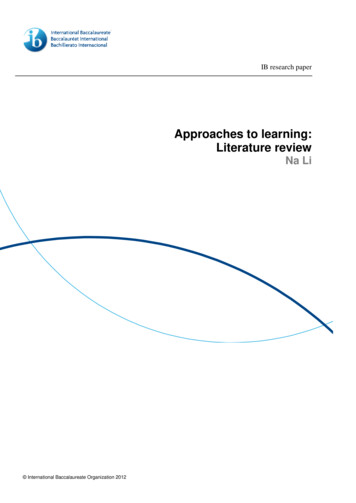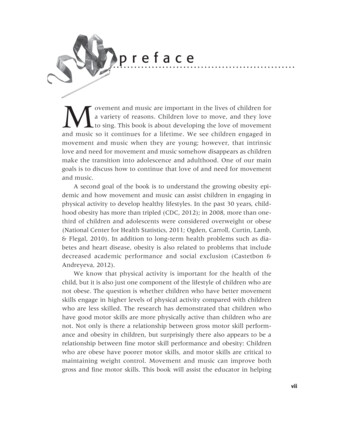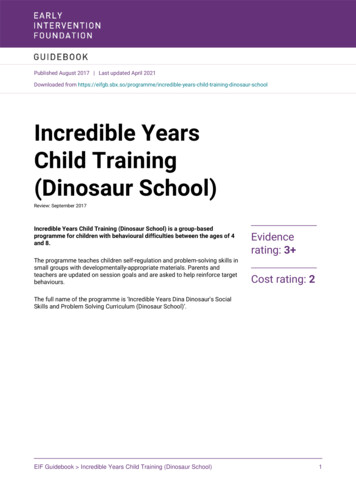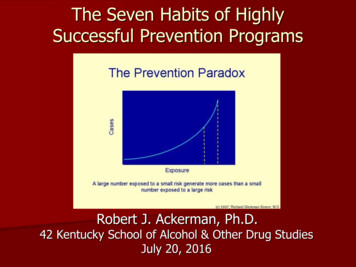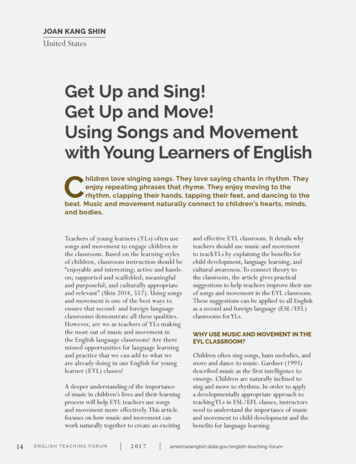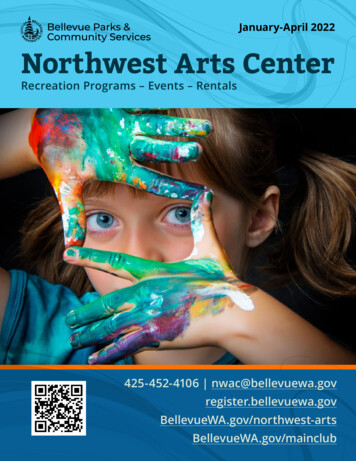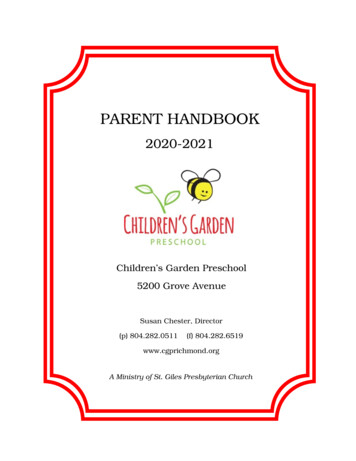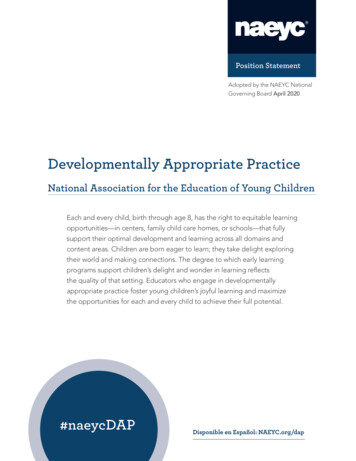
Transcription
Position StatementAdopted by the NAEYC NationalGoverning Board April 2020Developmentally Appropriate PracticeNational Association for the Education of Young ChildrenEach and every child, birth through age 8, has the right to equitable learningopportunities—in centers, family child care homes, or schools—that fullysupport their optimal development and learning across all domains andcontent areas. Children are born eager to learn; they take delight exploringtheir world and making connections. The degree to which early learningprograms support children’s delight and wonder in learning reflectsthe quality of that setting. Educators who engage in developmentallyappropriate practice foster young children’s joyful learning and maximizethe opportunities for each and every child to achieve their full potential.#naeycDAPDisponible en Español: NAEYC.org/dap
Developmentally Appropriate Practice3 Introduction355PurposeStatement of the PositionDefining Developmentally Appropriate Practice6 Core Considerations to Inform Decision Making8 Principles of Child Development and Learningand Implications That Inform Practice14 Guidelines for Developmentally Appropriate Practice in Action:Using Knowledge of Child Development and Learning in Context1518192125281. Creating a Caring, Equitable Community of Learners2. Engaging in Reciprocal Partnerships with Families and Fostering Community Connections3. Observing, Documenting, and Assessing Children’s Development and Learning4. Teaching to Enhance Each Child’s Development and Learning5. Planning and Implementing an Engaging Curriculum to Achieve Meaningful Goals6. Demonstrating Professionalism as an Early Childhood Educator29 Recommendations for Implementing Developmentally Appropriate Practice30313132321. Recommendations for Schools, Family Child Care Homes, and Other Program Settings2. Recommendations for Higher Education and Adult Development3. Recommendations for Policymakers4. Recommendations for ResearchConclusion33 Appendix A: History and Context35 Appendix B: Glossary38 Appendix C: Acknowledgements39 EndnotesNAEYC Position StatementPermissionsNAEYC accepts requests for limited use of our copyrighted material.For permission to reprint, adapt, translate, or otherwise reuse andrepurpose content from the final published document, review ourguidelines at ntally Appropriate Practice: A Position Statementof the National Association for the Education of Young Children.Copyright 2020 by the National Association for the Educationof Young Children. All rights reserved.
IntroductionPurposeChief among the professional responsibilities of early childhood educators is the responsibility toplan and implement intentional, developmentally appropriate learning experiences that promote thesocial and emotional development, physical development and health, cognitive development, andgeneral learning competencies of each child served.1 But what does it mean to be “developmentallyappropriate”? This position statement, one of five foundational documents developed by NAEYCin collaboration with the early childhood profession to advance high-quality early learning forall young children, defines the term. The definition emerges from a set of evidence-based coreconsiderations and principles of child development and learning, all of which are explained in theprinciples section of this statement. To support educators’ use of developmentally appropriatepractice, this statement also identifies guidelines for decision making in six key areas of responsibilitythat correspond to the Professional Standards and Competencies for Early Childhood Educators.2NAEYC’s Foundational DocumentsDevelopmentallyAppropriatePractice alStandards andCompetencies forEarly ChildhoodEducatorsCode ofEthical ConductAdvancingEquity in EarlyChildhoodEducationA POSITION STATEMENT OF THE NATIONAL ASSOCIATION FOR THE EDUCATION OF YOUNG CHILDREN 3
This statement’s primary focus is on the decisions early childhoodeducators make that result in developmentally appropriatepractice. It is important to note, however, that educatorsmake these decisions within settings that include their specificprograms as well as broader systems, states, and societalcontexts. Decision making that advances developmentallyappropriate practice is facilitated when these systems alsoreflect the tenets described within this statement. Therefore, inaddition to identifying guidelines for early childhood educators,the statement makes specific recommendations for policies andactions needed to support educators as they strive to implementdevelopmentally appropriate practice—in their work settings,through professional preparation and development, in publicpolicy, and through continuing research.This is the fourth edition of NAEYC’s position statement ondevelopmentally appropriate practice. (For a brief history andsummary of changes from previous editions, see Appendix A.)More extensively than in previous editions, the definition, coreconsiderations, principles, guidelines, and recommendationsall underscore the importance of social, cultural, and historicalcontexts. This broader view emphasizes the implications ofcontexts not only for each child, but also for all the adults(educators, administrators, and others) involved in any aspectof early childhood education.We begin this statement noting multiple tensions:1.2.This position statement is based on a synthesis of currentresearch and evidence across multiple disciplines. Althoughresearch finds that culture and context matter, relativelylittle research has been conducted with children from nonWhite and non-middle-class backgrounds. There is also aneed for additional research led by those who reflect thediversity of children and families and their lived experiences.This position statement requires well-prepared and qualifiedearly childhood educators to engage in effective decisionmaking. Yet insufficient funding and other policy decisions(for example, budget-driven decisions related to groupsize and ratios or mandated curricula and assessmentsthat do not reflect the principles of development andlearning identified here) have resulted in suboptimalenvironments, challenging working conditions, andinadequate compensation that make it difficult for earlychildhood educators to implement these guidelines.4 DEVELOPMENTALLY APPROPRIATE PRACTICE3.This position statement elevates the crucial supporteducators require from higher education and otherprofessional development systems. Yet even as theygrapple with their own institutional biases and inequities,professional preparation programs and ongoing professionaldevelopment systems must orient themselves towardsconsistently and effectively preparing and supportingeducators to reflect on and address their own inherentbiases and to help them provide developmentally, culturally,and linguistically responsive learning experiences toan increasingly diverse population of children.4.This position statement highlights the importance oflearning experiences that are meaningful to each childand that provide active engagement through play,exploration, and inquiry in ways that support the wholechild—socially, emotionally, physically, and cognitively. Yetsuch opportunities are too often denied to young childrenwhen educational practices are not responsive to theirdevelopmental, cultural, and linguistic characteristics.5.This position statement is based on NAEYC’s core valuesand beliefs, which underscore the fundamental right of eachand every child to live in a society dedicated to helping themachieve their full potential. Yet the historical and currentinequitable distribution of societal power and privilege onthe basis of race, ethnicity, gender, language, disability, andother social identities results in limited opportunities andharms children—as well as early childhood professionals.3Each of these tensions must be addressed for each child toachieve their full potential. We offer this statement as a call toaction, committing to work collectively to address the ways inwhich current realities constrain the full potential of all youngchildren as we continue to reflect and learn from multiple,diverse perspectives.
Statement of the PositionEach and every child, birth through age 8, has the right to equitable learning opportunities—incenters, family child care homes, or schools—that fully support their optimal development andlearning across all domains and content areas. Children are born eager to learn; they take delightexploring their world and making connections. The degree to which early learning programssupport children’s delight and wonder in learning reflects the quality of that setting. Educatorswho engage in developmentally appropriate practice foster young children’s joyful learningand maximize the opportunities for each and every child to achieve their full potential.Defining Developmentally Appropriate PracticeNAEYC defines “developmentally appropriate practice” asmethods that promote each child’s optimal development andlearning through a strengths-based, play-based approach tojoyful, engaged learning. Educators implement developmentallyappropriate practice by recognizing the multiple assets all youngchildren bring to the early learning program as unique individualsand as members of families and communities. Building oneach child’s strengths—and taking care to not harm any aspectof each child’s physical, cognitive, social, or emotional wellbeing—educators design and implement learning environmentsto help all children achieve their full potential across all domainsof development and across all content areas. Developmentallyappropriate practice recognizes and supports each individualas a valued member of the learning community. As a result,to be developmentally appropriate, practices must also beculturally, linguistically, and ability appropriate for each child.The Developmentally Appropriate Practice Position Statementis a framework of principles and guidelines to support a teacher’sintentional decision making for practice. The principles serveas the evidence base for the guidelines for practice, and bothare situated within three core considerations—commonality,individuality, and context.A POSITION STATEMENT OF THE NATIONAL ASSOCIATION FOR THE EDUCATION OF YOUNG CHILDREN 5
Core Considerationsto Inform Decision MakingDevelopmentally appropriate practice requires early childhood educators to seek out and gainknowledge and understanding using three core considerations: commonality in children’s developmentand learning, individuality reflecting each child’s unique characteristics and experiences, and thecontext in which development and learning occur. These core considerations apply to all aspects ofeducators’ decision-making in their work to foster each child’s optimal development and learning.1Commonality—current research and understandingsof processes of child development and learning thatapply to all children, including the understanding thatall development and learning occur within specificsocial, cultural, linguistic, and historical contextsAn ever-increasing body of research documents the tremendousamount of development and learning that occur from birththrough age 8 across all domains and content areas and howfoundational this development and learning is for later life.4This extensive knowledge base, including both what is knownabout general processes of children’s development and learningand the educational practices educators need to fully supportdevelopment and learning in all areas, is summarized in theprinciples section of this statement.When considering commonalities in development and learning,it is important to acknowledge that much of the researchand the principal theories that have historically guided earlychildhood professional preparation and practice have primarilyreflected norms based on a Western scientific-cultural model.5,6Little research has considered a normative perspective basedon other groups. As a result, differences from this Western6 DEVELOPMENTALLY APPROPRIATE PRACTICE(typically White, middle-class, monolingual English-speaking)norm have been viewed as deficits, helping to perpetuatesystems of power and privilege and to maintain structuralinequities.7, 8 Increasingly, theories once assumed to be universalin developmental sciences, such as attachment, are nowrecognized to vary by culture and experience.9The current body of evidence indicates that all child developmentand learning—actually, all human development and learning—are always embedded within and affected by social and culturalcontexts.10 As social and cultural contexts vary, so too doprocesses of development and learning. Social and culturalaspects are not simply ingredients of development and learning;these aspects provide the framework for all development andlearning. For example, play is a universal phenomenon acrossall cultures (it also extends to other primates). Play, however,can vary significantly by social and cultural contexts as childrenuse play as a means of interpreting and making sense of theirexperiences.11 Early childhood educators need to understand thecommonalities of children’s development and learning and howthose commonalities take unique forms as they reflect the socialand cultural frameworks in which they occur.
2Individuality—the characteristics and experiencesunique to each child, within the context of theirfamily and community, that have implications forhow best to support their development and learningEarly childhood educators have the responsibility of getting toknow each child well, understanding each child as an individualand as a family and community member. Educators use a varietyof methods—including reflecting on their knowledge of thecommunity; seeking information from the family; observing thechild; examining the child’s work; and using authentic, valid,and reliable individual child assessments. Educators understandthat each child reflects a complex mosaic of knowledge andexperiences that contributes to the considerable diversityamong any group of young children. These differences includethe children’s various social identities, interests, strengths, andpreferences; their personalities, motivations, and approaches tolearning; and their knowledge, skills, and abilities related to theircultural experiences, including family languages, dialects, andvernaculars. Children may have disabilities or other individuallearning needs, including needs for accelerated learning.Sometimes these individual learning needs have been diagnosed,and sometimes they have not.Early childhood educators recognize this diversity and theopportunities it offers to support all children’s learning byrecognizing each child as a unique individual with assetsand strengths to contribute to the early childhood educationlearning environment.3Context—everything discernible about thesocial and cultural contexts for each child, eacheducator, and the program as a wholeOne of the key updates in this revision is the expansion of thecore consideration regarding the social and cultural contexts ofdevelopment and learning. As noted in the first core considerationon commonality, the fact that development and learning areembedded in social and cultural contexts is true of all individuals.Context includes both one’s personal cultural context (that is, thecomplex set of ways of knowing the world that reflect one’s familyand other primary caregivers and their traditions and values)and the broader multifaceted and intersecting (for example,social, racial, economic, historical, and political) cultural contextsin which each of us live. In both the individual- and societaldefinitions, these are dynamic rather than static contexts thatshape and are shaped by individual members as well as otherfactors.Early childhood educators must also be aware that theythemselves—and their programs as a whole—bring their ownexperiences and contexts, in both the narrower and broaderdefinitions, to their decision-making. This is particularlyimportant to consider when educators do not share the culturalcontexts of the children they serve. Yet even when educatorsappear to share the cultural contexts of children, they cansometimes experience a disconnection between their professionaland cultural knowledge.12To fully support each child’s optimal development and learningin an increasingly diverse society, early childhood educators needto understand the implications of these contexts. By recognizingthat children’s experiences may vary by their social identities (forexample, by race or ethnicity, language, gender, class, ability, familycomposition, and economic status, among others), with differentand intersecting impacts on their development and learning,educators can make adaptations to affirm and support positivedevelopment of each child’s multiple social identities. Additionally,educators must be aware of, and counter, their own and largersocietal biases that may undermine a child’s positive developmentand well-being. Early childhood educators have a professionalresponsibility to be life-long learners who are able to foster life-longlearning in children; in this, they must keep abreast of researchdevelopments, while also learning continuously from families andcommunities they serve.A POSITION STATEMENT OF THE NATIONAL ASSOCIATION FOR THE EDUCATION OF YOUNG CHILDREN 7
Principles of Child Development and Learningand Implications That Inform PracticeNAEYC’s guidelines and recommendations for developmentally appropriate practice are based onthe following nine principles and their implications for early childhood education professional practice.These principles reflect an extensive research base that is only partially referenced here.13 Becausethese principles are interrelated, this linear list does not fully represent their overall complexity.1Development and learning are dynamic processesthat reflect the complex interplay between a child’sbiological characteristics and the environment, eachshaping the other as well as future patterns of growth.Advances in neuroscience over the last two decades have providednew insights regarding the processes of early brain developmentand their long-term implications for development and learning.The findings provide robust evidence supporting the importanceof high-quality early learning experiences for young children forpromoting children’s lifelong success.Neural connections in the brain—which are the basis for allthought, communication, and learning—are established mostrapidly in early childhood.14 The processes of forming newneural connections and pruning the neural connections thatare not used continue throughout a person’s lifespan but aremost consequential in the first three years.15 When adults aresensitive and respond to an infant’s babble, cry, or gesture, theydirectly support the development of neural connections that laythe foundation for children’s communication and social skills,including self-regulation. These “serve and return” interactionsshape the brain’s architecture.16 They also help educators andothers “tune in” to the infant and better respond to the infant’swants and needs.The interplay of biology and environment, present at birth,continues through the preschool years and primary grades(kindergarten through grade 3). This has particular implicationsfor children who experience adversity. In infancy, for example,a persistent lack of responsive care results in the infantexperiencing chronic stress that may negatively impact braindevelopment and may delay or impair the development ofessential systems and abilities, including thinking, learning,and memory, as well as the immune system and the ability tocope with stress.17 Living in persistent poverty can also generatechronic stress that negatively affects the development of brainareas associated with cognitive and self-regulatory functions.188 DEVELOPMENTALLY APPROPRIATE PRACTICENo group is monolithic, and data specific to communitiesprovides a deeper understanding of children’s experiences andoutcomes. It is important to recognize that although children ofall races and ethnicities experience poverty and other adversechildhood experiences (ACEs), Black and Latino/a children, aswell as children in refugee and immigrant families, children insome Asian-American families, and children in Native Americanfamilies, have been found to be more likely to experience ACEsthan White non-Latino/a and other Asian-American populationsof children,19 reflecting a history of systemic inequities.20Moreover, racism itself must be recognized not only for itsimmediate and obvious impacts on children, but also for itslong-term negative impacts, in which the repetitive traumacreated by racism can predispose individuals to chronic disease.21It should be noted that these stressors and trauma affect adults aswell as children, including family members and early childhoodeducators themselves, who, despite their skills and importance,often earn wages that place them into poverty.Some children appear to be more susceptible than others tothe effects of environmental influence—both positive andnegative—reflecting individual differences at play. For childrenfacing adverse circumstances, including trauma, the bufferingeffects of caring, consistent relationships—with family and othercommunity members but also in high-quality early childhoodprograms—are also important to note.22 This emerging scienceemphasizes the critical importance of early childhood educatorsin providing consistent, responsive, sensitive care and educationto promote children’s development and learning across the fullbirth-through-8 age span. The negative impacts of chronic stressand other adverse experiences can be overcome. High-qualityearly childhood education contributes substantially to children’sresilience and healthy development.
2All domains of child development—physicaldevelopment, cognitive development, social andemotional development, and linguistic development(including bilingual or multilingual development), aswell as approaches to learning—are important; eachdomain both supports and is supported by the others.Early childhood educators are responsible for fostering children’sdevelopment and learning in all these domains as well as in generallearning competencies and executive functioning, which includeattention, working memory, self-regulation, reasoning, problemsolving, and approaches to learning. There is considerable overlapand interaction across these domains and competencies. Forexample, sound nutrition, physical activity, and sufficient sleepall promote children’s abilities to engage in social interactionsthat, in turn, stimulate cognitive growth. Children who experiencepredictable, responsive relationships and responsive interactionswith adults also tend to demonstrate improved general learningcompetencies and executive functioning.23Changes in one domain often impact other areas and highlighteach area’s importance. For example, as children begin to crawlor walk, they gain new possibilities for exploring the world. Thismobility in turn affects both their cognitive development and theirability to satisfy their curiosity, underscoring the importance ofadaptations for children with disabilities that limit their mobility.Likewise, language development influences a child’s ability toparticipate in social interaction with adults and other children;such interactions, in turn, support further language developmentas well as further social, emotional, and cognitive development.Science is clear that children can learn multiple languages aseasily as one, given adequate exposure and practice, and thisprocess brings cognitive advantages.24 In groups in which childrenspeak different home languages, educators may not be able tospeak each language, but they can value and support maintainingall languages.25A growing body of work demonstrates relationships between social,emotional, executive function, and cognitive competencies26 as wellas the importance of movement and physical activity.27 These areasof learning are mutually reinforcing and all are critical in educatingyoung children across birth through age 8. Intentional teachingstrategies, including, and particularly, play (both self-directed andguided), address each domain. Kindergartens and grades 1-3 tendto be considered elementary or primary education, and, as such,may have increasingly prioritized cognitive learning at the expenseof physical, social, emotional, and linguistic development. Butintegrating cognitive, emotional, social, interpersonal skills andself-regulatory competencies better prepares children for morechallenging academic content and learning experiences.28 In brief,the knowledge base documents the importance of a comprehensivecurriculum and the interrelatedness of the developmental domainsfor all young children’s well-being and success.3Play promotes joyful learning that fosters selfregulation, language, cognitive and social competenciesas well as content knowledge across disciplines. Playis essential for all children, birth through age 8.Play (e.g., self-directed, guided, solitary, parallel, social,cooperative, onlooker, object, fantasy, physical, constructive, andgames with rules) is the central teaching practice that facilitatesyoung children’s development and learning. Play develops youngchildren’s symbolic and imaginative thinking, peer relationships,language (English and/or additional languages), physicaldevelopment, and problem-solving skills. All young children needdaily, sustained opportunities for play, both indoors and outdoors.Play helps children develop large-motor and fine-motor physicalcompetence, explore and make sense of their world, interact withothers, express and control their emotions, develop symbolicand problem-solving abilities, and practice emerging skills.Consistently, studies find clear links between play and foundationalcapacities such as working memory, self-regulation, oral languageabilities, social skills, and success in school.29Indeed, play embodies the characteristics of effective developmentand learning described in principles 4 and 5—active, meaningfulengagement driven by children’s choices. Researchers studying thepedagogy of play have identified three key components: choice(the children’s decisions to engage in play, as well as decisionsabout its direction and its continuation), wonder (children’scontinued engagement as they explore, gather information, testhypotheses, and make meaning), and delight (the joy and laughterassociated with the pleasure of the activity, making discoveries,and achieving new things).30 Play also typically involves socialinteraction with peers and/or adults.Although adults can be play partners (for example, playingpeekaboo with an infant) or play facilitators (by making asuggestion to extend the activity in a certain way), the morethat the adult directs an activity or interaction, the less likely itwill be perceived as play by the child. When planning learningenvironments and activities, educators may find it helpful toconsider a continuum ranging from children’s self-directed playto direct instruction.31 Neither end of the continuum is effectiveby itself in creating a high-quality early childhood program.Effective, developmentally-appropriate practice does not meansimply letting children play in the absence of a planned learningenvironment, nor does it mean predominantly offering directinstruction. In the middle of the continuum is guided play.Educators create learning environments that reflect children’sinterests; they provide sustained time and opportunities forchildren to engage in self-directed play (individually and insmall groups). Educators also strategically make comments andsuggestions and ask questions to help move children toward alearning goal, even as children continue to lead the activity.32A POSITION STATEMENT OF THE NATIONAL ASSOCIATION FOR THE EDUCATION OF YOUNG CHILDREN 9
Guided play gives educators opportunities to use children’sinterests and creations to introduce new vocabulary andconcepts, model complex language, and provide children withmultiple opportunities to use words in context in children’s homelanguages as well as in English. These meaningful and engagingexperiences help children—including those in kindergarten andthe primary grades—build knowledge and vocabulary acrosssubject areas and in purposeful contexts (which is more effectivethan memorization of word lists).33Despite evidence that supports the value of play, not allchildren are afforded the opportunity to play, a reality whichdisproportionately affects Black and Latino/a children.34 Playis often viewed as being at odds with the demands of formalschooling, especially for children growing up in under-resourcedcommunities.35 In fact, the highly didactic, highly controllingcurriculum found in many kindergarten and primary grades, withits narrow focus on test-focused skill development, is unlikelyto be engaging or meaningful for children; it is also unlikely tobuild the broad knowledge and vocabulary needed for readingcomprehension in later grades. Instead, the lesson children arelikely to learn is that they are not valued thinkers or successfullearners in school. For example, studies suggest that studentswho are taught math primarily through memorization and rotelearning are more than a year behind those who have beentaught by relating math concepts to their existing knowledge andreflecting on their own understanding.36Even if not called play, cross-curricular and collaborativeapproaches such as project-based learning, inquiry learning, ormaking and tinkering share characteristics of playful learning.37Giving children autonomy and agency in how they approachproblems, make hypotheses, and explore potential solutionswith others promotes deeper learning and i
This is the fourth edition of NAEYC’s position statement on developmentally appropriate practice. (For a brief history and summary of changes from previous editions, see Appendix A.) More extensively than in previous editions, the definition, core co
